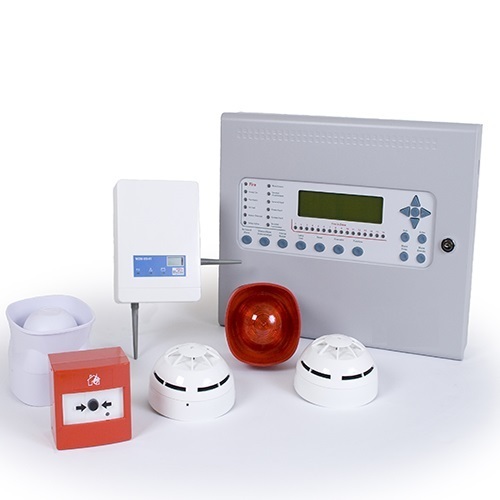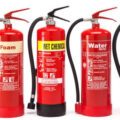What is a fire alarm system?
A fire alarm system has a number of devices working together to detect and warn people through visual and audio appliances when smoke, fire, carbon monoxide or other emergencies are present. These alarms may be activated automatically from smoke detectors, and heat detectors or may also be activated via manual fire alarm activation devices such as manual call points or pull stations. Alarms can be either motorized bells or wall mountable sounders or horns. They can also be speaker strobes which sound an alarm, followed by a voice evacuation message which warns people inside the building not to use the elevators. Fire alarm sounders can be set to certain frequencies and different tones including low, medium and high, depending on the country and manufacturer of the device.
Consequences of Fire Outbreaks
A fire can have far reaching impact on the institution’s buildings, contents and mission. General consequences may include:
Property damage: Most houses, building or institutions house unique and irreplaceable objects. Fire generated heat and smoke can severely damage or totally destroy these items beyond repair.
Structure damage: Buildings provide the “shell” that safeguards collections, operations and occupants from weather, pollution, vandalism and numerous other environmental elements. A fire can destroy walls, floors, ceiling/roof assemblies and structural support, as well as systems that illuminate, control temperature and humidity, and supply electrical power. This can in turn lead to content harm, and expensive relocation activities.
Injury or loss of life: The lives of occupants, staff and visitors can be endangered.
Building security: A fire represents the single greatest security threat! Given the same amount of time, an accidental or intentionally set fire can cause far greater harm to collections than the most accomplished thieves. Immense volumes of smoke and toxic gases can cause confusion and panic, thereby creating the ideal opportunity for unlawful entry and theft. Unrestricted firefighting operations will be necessary, adding to the security risk. Arson fires set to conceal a crime are common.
To minimize fire risk and its impact, it is important to develop and implement comprehensive and objective fire protection programs. Program elements should include fire prevention efforts, building construction improvements, methods to detect a developing fire and alert emergency personnel, and means to effectively extinguish a fire. Each component is important toward overall accomplishment of the fire safety goal.
Types of Fire and Smoke Detectors
Fire alarms are found in Offices, Factories, and public buildings, they are a part of our everyday routine but are often overlooked until there is an emergency at which point, they might just save our lives. Whatever the method of detection is, if the alarm is triggered, sounders will operate to warn people in the building that there may be a fire and to evacuate. The fire alarm system may also incorporate a remote signal system which could then alert the fire brigade via a central station.
Components of Fire Alarm Detectors
At the core of a fire alarm system are the detection devices, from sophisticated intelligent smoke detectors to simple manually operated break glass units, there are a wide array of different types, but we can divide them into groups including:
– Heat detectors
– Smoke detectors
– Carbon Monoxide detectors
– Multi-sensor detectors
– Manual Call Points
Heat Detectors
Heat detector can either work on a fixed temperature basis, where it will trigger an alarm if the temperature exceeds a pre-set value or they can work on the rate of change in temperature.
How Heat detectors work: Commonly Heat detectors work in a similar way to an electrical fuse, the detectors contain a eutectic alloy which is heat sensitive when a certain temperature is reached the alloy turns from a solid to a liquid which in turn triggers the alarm.
Smoke Detectors
There are three basic types of smoke detectors including:
– Ionization
– Light Scattering
– Light Obscuring
Ionization Smoke Detector : Ionization Smoke detector generally contains two chambers. The first is used as a reference to compensate for changes in ambient temperature, humidity or pressure.
The second chamber contains a radioactive source, usually alpha particle, which ionizes the air passing through the chamber where a current flows between two electrodes. When smoke enters the chamber the current flow decreases. This drop in current flow is used to initiate an alarm.
Light Scattering Smoke Detector: The light scattering smoke detector operates on the Tyndall effect; a photocell and light source are separated from each other by a darkened chamber such that the light source does not fall on the photocell.The passage of smoke into the chamber causes the light from the source to be scattered and fall on the photocell. The photocell output is being used to initiate an alarm.
Light Obscuring Smoke Detector: In the Light obscuring smoke detector, smoke interferes with a light beam between a light source and photocell. The photocell measures the amount of light it receives. The variation in photocell output, is being used to initiate an alarm. This type of detection can be used to protect large areas with the light source and photocell positioned some distance apart.
Carbon Monoxide Detectors
Carbon monoxide detectors are known also as CO fire detectors are electronic detectors used to indicate the outbreak of fire by sensing the level of carbon monoxide in the air. Carbon monoxide is a poisonous gas produced by combustion.
In this instance, these detectors are not the same as Carbon monoxide detectors used in the home for protecting residents against carbon monoxide produced by incomplete combustion in appliances such as gas fires or boilers.
Carbon Monoxide fire detectors use the same type of sensor as those in the home but are more sensitive and respond more quickly. Carbon monoxide detectors have an electrochemical cell, which senses carbon monoxide, but not smoke or any other combustion products
Multi-Sensor Detectors
The Multi-sensor detectors combine inputs from both optical and heat sensors and process them using a sophisticated algorithm built into the detector circuitry. When polled by the control panel the detector returns a value based on the combined responses from both the optical and heat sensors. They are designed to be sensitive to a wide range of fires.
Manual Call Points
A Manual Call Point or Break Glass Call Point is a device which enables personnel to raise the alarm by breaking the frangible element on the fascia; this then triggers the alarm.
Types of Fire Alarm Systems
Fire Alarm Systems can be broken down into four main types;
– Conventional
– Addressable
– Intelligent
– Wireless
Let’s spend some time considering each.
Conventional Fire Alarm Systems
In a Conventional Fire Alarm System, physical cabling is used to interconnect several call points and detectors, the signals from which are wired back to the main control unit.Call points and detectors are arranged in “Zones” to simplify locating the cause of the alarm, this is important for both the fire brigade and general building management.
Each zone is indicated at the Fire Alarm Control Panel either with an indicator lamp, a text display or in some cases both. It makes sense that the more we can divide a building into zones, the more accurate locating the alarm trigger will be. The Control Panel is wired to a minimum of two sounder circuits which could contain bells, electronic sounders or other audible devices. It is these devices which sound the alarm when triggered.
Addressable Fire Alarm Systems
The detection principle of an Addressable System is the same as a Conventional System except that each detector is given a set Address (usually by means of a dip-switch) and the Control Panel can then determine exactly which detector or call point has initiated the alarm. The detection circuit is wired as a loop and up to 99 devices may be connected to each loop.
It is common for the loop to be fitted with Loop Isolation Modules so that the loop is sectioned in order to ensure that a short circuit or single fault will only cause the loss of a small part of the system; allowing the rest of the system to function normally.
In the previous two systems, the “Conventional Fire Alarm System” and the “Addressable Fire Alarm System” the detectors are not considered “intelligent” as they can only give output signals representing the value of detected phenomena. It is left up to the Control Unit to decide whether there is a fire, fault, pre-alarm or other.
Intelligent Fire Alarm Systems
However, in our next type of System, which is an Intelligent Fire Alarm system, each detector effectively incorporates its own computer which evaluates the environment around it and communicates to the Control Panel whether there is a fire, fault or the detector head needs cleaning. Essentially Intelligent Systems are far more complex and incorporate far more facilities than Conventional or Addressable Systems. Their primary purpose is to help prevent the occurrence of false alarms. Intelligent Fire Alarm Systems are available in 2, 4, and 8 loop versions which means large premises can be monitored from one single panel.
Wireless Fire Alarm Systems
The final type of system we will consider is the Wireless Fire Alarm System. These are an effective alternative to traditional wired fire alarm systems for all applications. They utilize secure, license-free radio communications to interconnect the sensors and devices with the controllers. It is a simple concept, which provides many unique benefits and is a full intelligent fire detection system without the need for cabling.
In this article, we have learned that Fire Alarm systems are fitted in many buildings we encounter every day and that they are used to warn people within the building of an emergency fire-related situation.






